Gotham Gazette's Reading NYC Book Club discussed historic preservation and urban development at its meeting on February 28, 2007. Two guest authors joined the meeting: Kevin Walsh, whose book Forgotten New York (based on his Web site by the same name) is a tribute to the city's historic sites, and Roberta GRATZ, author of two books about urban development “ The Living City and Cities Back From the Edge – and one of the commissioners on the city's Landmarks Preservation Commission. The following is an edited transcript.
FORGOTTEN NEW YORK
GOTHAM GAZETTE: Mr. Walsh, how did you come up with Forgotten New York? How did you get started with it?
KEVIN WALSH: Well, I'm happy to be here in the Jefferson Market Library, formerly a women's prison – well, actually this was the courthouse; the prison was across the street. This is my first time in the building, but I've been up in the clock tower during Open House New York. You go up in the tower, and you can see all of Greenwich Village.
Anyway, to the point at hand, I started Forgotten New York in 1998. But I think it was an event that happened in my life in 1963 that led to its genesis. I was living on 6th Avenue and 83rd Street in Bay Ridge Brooklyn. I was a kid, although I would continue to live there until the early 1980s. Across the street they tore down everything to build the Gowanus expressway, which was the on-ramp to the Verrazano Bridge. I saw the bridge built, and I'm very happy about that. It's a landmark and hopefully it will be there for 1,000 years.
But to do that, they had to tear down everything across the street from me. They did that in 1958 or 1959, and they left it empty for years. My father took a camera and took photos of it, documented it. It's on my Verrazano Bridge page.
In 1963, they also eliminated all the cast iron lampposts on 6th avenue. These lampposts dated back to 1910. Overnight, they were wiped out. Even at that young age, I had been filling notebooks with drawings of these cast iron lampposts, in all their different designs.
Those two events put a kernel in my head: you better get stuff on camera before they destroy it. Much to my regret, I didn't do anything about it until 1998. Imagine if I had done that all those years.
With the onset of the Internet, I got the idea of doing a Web site called Forgotten New York about all the things that you see in the street that are unusual, unnoted, that people don't look at or don't see.
In New York everybody's rushing around. They're not looking up, they're not looking down. They just want to get where they're going. But I took a slow walk around, and took a bicycle, and looked at the painted ads on the side of buildings. Some of these things go back to the 1880s. There's one on 17th street and 6th avenue that talks about Victorian carriages and trotters for horses. We call them Wall Dogs ads, because the guys who used to paint them were called wall dogs.
I took photographs of all this ephemera – all these things that people had not noticed. I got a critical mass of 50 pages together, and I set up the Web site. We have been around for eight years, and we've got four million hits so far. So it's been moderately popular.
In 2003, Harper Collins approached me. I didn't have to go through the normal things that authors go through – agents, book proposals and all that. It was easy. They came to me and said how would you like to do a book. I thought about it for two seconds, and said, "of course I'd like to do a book." And here it is, and I'm proud of it.
GOTHAM GAZETTE: Can you go through some of your favorite forgotten places?
KEVIN WALSH: Well, there are some places that I took pictures of for Forgotten New York that are not there anymore. Now, the only place they exist is in photographs:
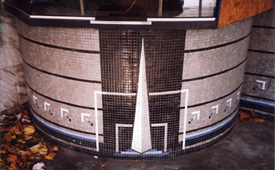 |
Trylon Theater: This is a mosaic representation of the Trylon: the symbol of the 1939/1940 World's Fair. Up until 2005, this was part of the ticket booth at the Trylon theater. This is the last mosaic representation of the World's Fair Trylon. It was built the same year as the World's Fair. A few years ago they decided to renovate the theater, and they hammered it into oblivion. |
| Flessels Restaurant: This is Flessels restaurant. It was one of the last beer gardens left in New York City. There is one left, the Bohemian Hall in Astoria. But this was another one that had been in existence since the late 19th Century. I moved into Flushing in 1993. This building was still active and serving drinks until 1997. To my eternal regret, I never got the chance to go in there. Then I heard they were going to tear it down, so I ran over there and took a picture of it before they could destroy it. |
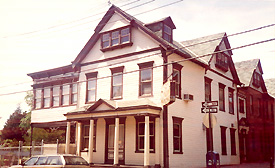 |
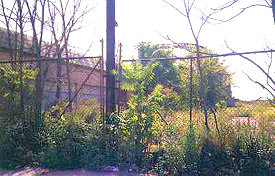 |
The Thuderbolt: This is the Thunderbolt roller coaster in Coney Island. When the city developed Keyspan Park in 2000, the developers thought it was an eyesore. Admittedly it had fallen into decrepitude, but it should have been preserved, should have been saved. |
| Williamsburg Bridge: When they renovated the Williamsburg Bridge a couple of years ago they got rid of these beautiful wrought iron WB symbols on the pedestrian rails. These rails were on the approach ramps on both the Brooklyn and Manhattan sides. This one is seen in place in 1998. The last time I saw one of these was in a junkyard on Houston Street. Most of them are gone now. |
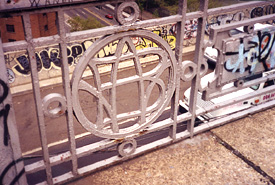 |
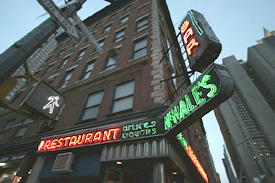 |
McHale's: This is the old McHale's Bar and Grille Restaurant on 8th Avenue and 46th Street. This was also demolished so they could build a huge luxury apartment building. When I last saw one of these signs it was in a thrift store on 24th Street. Hopefully somebody bought one and took it home. Maybe they hooked it up. |
That's what I've been doing in Forgotten New York. I photograph these things before people who are unaware of history – or who don't care about history – can come in knock it down and destroy it. We have the Landmarks Preservation Commission but it doesn't save everything. I guess it can't save everything. So I'm here with my camera.
BOOK CLUB MEMBER: Have you been though the entire city? Are there sections you haven't been to yet?
KEVIN WALSH: I've been to virtually every part of the city. There are some parts I haven't spent much time in – Hunts Point, Jamaica. I've only been to City Island a few times. I'm never going to be done with the research. There will always be little corners of the city that I haven't been to, although I hope I get to everything.
BOOK CLUB MEMBER: When you come across an unusual object, how do you go about researching it, and finding its history?
KEVIN WALSH: I have had to buy four bookshelves since I started Forgotten New York to house the books I get. Every time a new book about New York comes out, I'm on it. I'm always out looking for old books about New York, too. I'd love to get the Iconography of New York.
HISTORICAL PRESERVATION AND URBAN DEVELOPMENT
GOTHAM GAZETTE: Ms. Gratz, how did you get involved in historic preservation? What are some of your favorite spots in the city?
ROBERTA GRATZ: I was born in the Village. Where Bobst Library now stands is where I grew up. Somewhere along the line my interest in the city emerged, and I started writing about neighborhood fights for the New York Post, before Rupert Murdoch. People take landmarks for granted now, but when I was writing about them in the late 1960s and 1970s people were asking me why I was bothering.
I wrote a big series in 1973 about the weakness in the landmark law, which won all sorts of awards and helped change the law. When it was passed in 1965, the law only functioned for six months out of every three years. Everybody forgets that. For six months every three years the commission could designate landmarks, and in between the bulldozer worked overtime. You see a lot of references to Penn Station and the 1965 law as if it saved everything, but it was very weak. Aside from the limited time the commission worked, there were no interior designations, and no requirement that the city save its own buildings.
Even now, the Landmarks Preservation Commission only puts out a report; we can't force them. But it's pretty obligatory at this point. Of course, if you say things are weak now, you won't get any argument from me, even though I sit on the commission.
I write about urbanism from the bottom up, the local level. I don't believe I'm a critic of planners. I'm a critic of top-down planning. My books are all about success stories, things that worked out well because they were started by citizens.
One of my favorite places is the piers in Red Hook that were saved, restored and reinvigorated by Gregory O'Connell, a former cop. It's one of my favorite stories. When he was a cop, he would park his truck down by the waterfront to do his bookkeeping, and he would look at these warehouses, owned by either the Port Authority or the city, I forget which. Either way, owned by someone who didn't know what to do with this. They wanted to demolish them and build high rises that would be accessible to Wall Street by ferry. So O'Connell basically started buying these properties. He made them available to small businesses. He created a park out of recycled material. He made space available for community activity in the summer. He's an extraordinary developer-citizen, the perfect model. This is where the local Fairway opened, a deal he brokered in his space, and made sure that local jobs were available. It's the perfect example of what a civic-minded developer can do, while still making money.
GOTHAM GAZETTE: You have written how historical preservation is one part of an overall urban development strategy. Specifically, you write about Soho. Can you talk a little about how historical preservation was used there?
ROBERTA GRATZ: Soho emerged out of the fight against the Lower Manhattan Expressway. I write about this in my book Cities Back From The Edge, as a tribute to Jane Jacobs. She fought against that expressway, and in the process helped change the way that the country, and even the world, uses cities. That whole area was condemned by none other than our now-reconsidered Robert Moses. One of my commitments to Jane before she died was that I would put a few nails back into his coffin.
Moses designated that entire neighborhood for demolition for the expressway, killing the neighborhood. That neighborhood had industrial uses; there was real business there. But whenever you condemn a neighborhood for another use, you're effectively killing it. Nobody is going to move into it, none of the owners are going to invest in their property, and anybody on a lease is going to leave when the lease is over.
So the area was emptied out for the expressway. Artists moved in because landlords had empty space and nothing they could do with it. The landlords then took cash on a month- to-month basis under the table from artists. Step by step the artists got institutionalized, condoned even though their residence was illegal. When the expressway was killed, that's when artists started buying property or signing long-term leases. At the same time, art was changing, and they needed big spaces. Soho emerged out of all that.
PRESERVATION VERSUS PROGRESS?
GOTHAM GAZETTE: Since there is more demand now for space in the city, I would be interested in hearing about which areas both of you think are most threatened right now?
ROBERTA GRATZ: Everywhere.
KEVIN WALSH: Well, I did a page called "My Flushing is Gone", where I document the changes in my neighborhood. I moved there in 1993, and the pace of change has accelerated in recent years. Perfectly nice two-family buildings that were built around 1920 are all being torn down by developers who want to plan multi-family houses that are not designed very well. The new developers don't like grass or trees; they like cement. So everything is being cemented in Flushing.
Now, these buildings being supplanted are not historic buildings per say. But they are representative of a regime in the 1920s in which there were still some aesthetic values when they were building relatively affordable housing. Now affordable housing is awful stuff.
ROBERTA GRATZ: The same trends are happening everywhere. In areas like Queens, there were areas that grew up around the streetcar. So they are modest scale family housing within a ten or fifteen minute walk of the streetcar. One of the things that has happened in this city for the last ten or fifteen years that has been extraordinary is the influx of immigrants. It's the reason for our rejuvenation. Queens is one of the greatest examples of this. So you have a lot of pressure on neighborhoods. There is not a neighborhood in this city that is not feeling this.
GOTHAM GAZETTE: But if a neighborhood has been built around a streetcar that no longer exists, for instance, isn't that neighborhood going to have to change physically to meet its demographic makeup?
ROBERTA GRATZ: No. Soho did not change physically, even though it changed totally. It has since had new construction and things added on, but the buildings haven't changed. Only the occupancy has changed.
The houses that Kevin is talking about are perfectly useable. It's a matter of taste, and the dominance of the car. People now want urban housing with parking garages. To me, this is an oxymoron.
GOTHAM GAZETTE: So that's true in every case? The city doesn't have to change physically to meet its changing population?
ROBERTA GRATZ: No. The city needs to physically change, but there are ways to fit new development in with infill, adaptation, and expansion of existing buildings.
That's the significance of the West Village Houses, that emerged from the fight that Jane Jacobs was instrumental in. The theme in that fight was 'not one sparrow displaced.' What they did was design housing to be built in empty or underutilized sites. Nothing was taken away. There is not a neighborhood in the city that doesn't have such sites.
In Soho, the commission is approving new, sizable buildings all the time. They are either replacing nondescript buildings, or parking lots. But not one historic building is being lost in that project. Every week at the landmark commission we see the kind of incremental development that is never recognized as making a big change in the city. Every week we are getting requests for rooftop additions, backyard additions, and improvement of parking garages, conversions of commercial structures to residential and so on. It represents enormous investment. But in historic districts, it also protects the physical nature of the area, which is all the landmarks commission can do.
I think the city can expand, upgrade and change without losing its historic fabric.
DEBBIE ZANONI:
Why are there so many banks popping up, and why is it allowed? It seems like the green grocers have disappeared, the smaller, affordable restaurants have disappeared, and I find myself looking on a street corner, and there are four major banks, one on every corner. Is that just so people can get mortgages for all the condos? I don't understand how the city is allowing it, because it's becoming unlivable.
ROBERTA GRATZ: I don't know the answer, but I share in your feeling about it. This comes up at Landmarks Commission, where we are at least able to control signage in an historic district. The twist is that we can't control what happens on inside the windows. So every window inside has a sign.
THE UPPER WEST SIDE; THE LOWER EAST SIDE
SANDY MALTER: The institutions on the Upper West Side on Central Park West are pleading to be able to build high-rise condos on their adjacent properties. How do you feel about that?
ROBERTA GRATZ: The first thing on my agenda when I joined the landmarks commission was to make sure that Shearith Israel did not get its tower. That was my first of very few victories.
The historic district of the Upper West Side has a zoning overlay that dictates brownstone heights. I fashioned a compromise for that block because on that block are two 1920s apartment houses that are nine stories, one of which is next door to the Shearith Israel site. I said I could respect the nine stories because the precedent was there.
The Historical Society is going to be a huge fight, on two levels. One is a preposterous proposal to change the façade of the historical society itself under the erroneous idea that if they add windows so you can see inside, then you'll come in. Right across the street is the Museum of Natural History. There isn't a window in there, but somehow the crowds are never scarce. The historic society has also had huge crowds, like with the slavery exhibition. Among the commissioners, everybody feels that this is outrageous.
The tower [that the Historical Society wants to build] will eventually come up, and that will be a very interesting fight. I gather there are three developers in the final finish for the tower, one of who is Dan Doctoroff's best friend, Steve Ross. The mayor is for it, and this is going to be huge.
NORMAN SCHERER: What is going to happen with the Lower East Side and all the parking lots down there?
ROBERTA GRATZ: It's amazing how many small high rises are going up down there, eight or nine stories, of all styles imaginable. And I think that's fine. What you'll have is a real mix. It's not an historic district in an architectural sense, although it's very much an historic district in the urbanistic sense. I write about this in the epilogue of Living Cities, that the Lower East Side is the ultimate urban neighborhood, because of its absorption of immigrants, serving as a jumping off point for immigrants of all kinds. I watched the neighborhood go from Jewish to Chinese, and then Asian of all kinds. I don't know who will be the next group.
The Lower East Side is a good example of a place where you pick certain buildings as individual landmarks – the Eldridge Street Synagogue, the Jewish Daily Forward Building, the Education Alliance, maybe one or two bank buildings. Then you can at least call on this history of the neighborhood, while change takes its course around it. We do need additional density, and there are ways to add that density without losing essential buildings. That is one neighborhood that will see it happen.
Â




